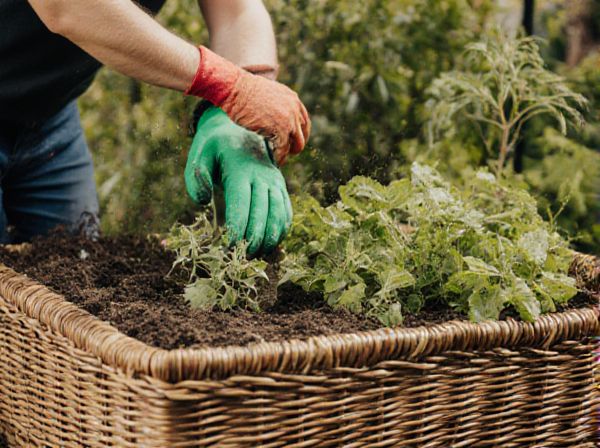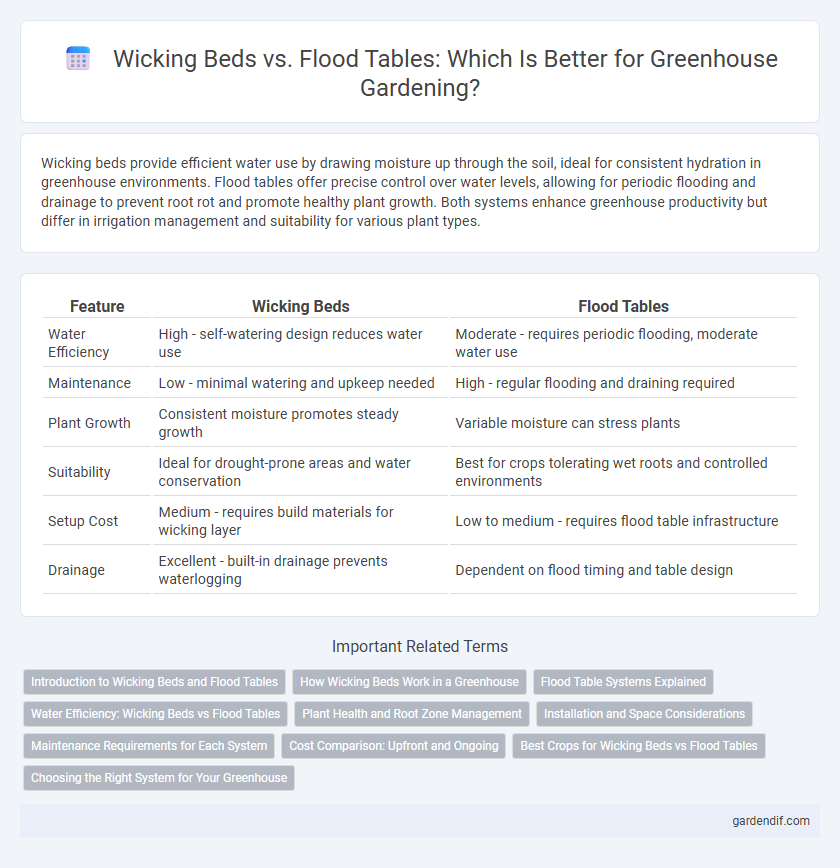
Wicking beds vs flood tables Illustration
Wicking beds provide efficient water use by drawing moisture up through the soil, ideal for consistent hydration in greenhouse environments. Flood tables offer precise control over water levels, allowing for periodic flooding and drainage to prevent root rot and promote healthy plant growth. Both systems enhance greenhouse productivity but differ in irrigation management and suitability for various plant types.
Table of Comparison
| Feature | Wicking Beds | Flood Tables |
|---|---|---|
| Water Efficiency | High - self-watering design reduces water use | Moderate - requires periodic flooding, moderate water use |
| Maintenance | Low - minimal watering and upkeep needed | High - regular flooding and draining required |
| Plant Growth | Consistent moisture promotes steady growth | Variable moisture can stress plants |
| Suitability | Ideal for drought-prone areas and water conservation | Best for crops tolerating wet roots and controlled environments |
| Setup Cost | Medium - requires build materials for wicking layer | Low to medium - requires flood table infrastructure |
| Drainage | Excellent - built-in drainage prevents waterlogging | Dependent on flood timing and table design |
Introduction to Wicking Beds and Flood Tables
Wicking beds are self-watering garden beds that use a water reservoir beneath the soil to deliver moisture directly to plant roots through capillary action, promoting efficient water use and reducing maintenance. Flood tables, commonly used in commercial greenhouses, are elevated flat surfaces designed to be periodically flooded, providing uniform water distribution for hydroponic or soil-grown crops. Both systems optimize water management but differ in irrigation methods, suitability for crop types, and operational complexity.
How Wicking Beds Work in a Greenhouse
Wicking beds in a greenhouse work by using a water reservoir beneath the soil that allows water to be drawn upward through capillary action, keeping the root zone consistently moist without overwatering. This system promotes efficient water usage, reduces evaporation, and supports healthy plant growth by maintaining optimal moisture levels. Compared to flood tables, wicking beds minimize water waste and provide better control over hydration, making them ideal for sustainable greenhouse cultivation.
Flood Table Systems Explained
Flood table systems in greenhouses provide efficient water management by allowing controlled flooding and draining, promoting optimal root hydration and nutrient uptake. These systems enhance plant growth by maintaining consistent moisture levels and reducing water waste compared to traditional soil beds. Flood tables support diverse crop varieties, improve disease control, and simplify maintenance, making them a sustainable choice for commercial and hobbyist growers.
Water Efficiency: Wicking Beds vs Flood Tables
Wicking beds optimize water efficiency by delivering moisture directly to plant roots through capillary action, reducing evaporation and runoff compared to flood tables. Flood tables require frequent water replenishment and can result in higher water loss due to surface exposure and drainage. Choosing wicking beds in greenhouses significantly conserves water while maintaining consistent soil moisture for healthier plant growth.
Plant Health and Root Zone Management
Wicking beds provide consistent moisture to plants by delivering water directly to the root zone, reducing stress and promoting healthier root development compared to flood tables, which periodically submerge roots and may cause fluctuations in oxygen levels. This steady moisture environment in wicking beds enhances nutrient uptake and minimizes root diseases, while flood tables require careful timing to prevent root rot due to temporary waterlogging. Effective root zone management in wicking beds supports vigorous plant growth by maintaining balanced moisture and aeration, essential for greenhouse crop productivity.
Installation and Space Considerations
Wicking beds require minimal installation with simple components, making them ideal for small greenhouse spaces due to their compact, self-watering design. Flood tables often involve more complex plumbing and elevated platforms, demanding more vertical and horizontal space for proper drainage and water circulation. Choosing between the two depends on available area, with wicking beds preferred for tight spaces and flood tables suited to larger, well-equipped greenhouses.
Maintenance Requirements for Each System
Wicking beds require regular monitoring of water levels to maintain optimal moisture, with occasional flushing to prevent salt buildup, while flood tables demand more frequent cleaning to avoid algae growth and clogging in drainage systems. Both systems benefit from routine checks for structural integrity, but flood tables often necessitate more intensive maintenance due to the complexity of water circulation mechanisms. Efficient upkeep ensures consistent plant health and maximizes productivity in greenhouse environments.
Cost Comparison: Upfront and Ongoing
Wicking beds typically have lower upfront costs due to simpler construction materials such as plastic containers and soil media, whereas flood tables require more investment in durable frameworks and plumbing systems. Ongoing expenses for wicking beds remain minimal with reduced water consumption and minimal maintenance, while flood tables incur higher operational costs related to water supply, pump electricity, and regular system checks. When comparing total cost of ownership for greenhouse irrigation, wicking beds offer a budget-friendly solution for small-scale growers, whereas flood tables suit larger operations with higher initial capital and maintenance budgets.
Best Crops for Wicking Beds vs Flood Tables
Wicking beds excel in growing water-sensitive crops such as lettuce, spinach, and herbs due to their self-watering mechanism that provides consistent moisture without waterlogging. Flood tables are ideal for hydroponic vegetables like tomatoes, cucumbers, and peppers, which benefit from nutrient-rich flood cycles and oxygenated root environments. Selecting the right system depends on crop water needs, with wicking beds favoring leafy greens and flood tables supporting heavier fruiting plants.
Choosing the Right System for Your Greenhouse
Wicking beds provide a self-watering system ideal for consistent moisture control and water efficiency, making them suitable for smaller greenhouse setups with limited water supply. Flood tables offer excellent flexibility for growing a wide variety of plants, allowing precise water level management and oxygenation, which benefits larger-scale greenhouse operations focused on commercial production. Selecting between these depends on factors like crop type, space availability, water resources, and maintenance preferences within your greenhouse environment.
Wicking beds vs flood tables Infographic

 gardendif.com
gardendif.com